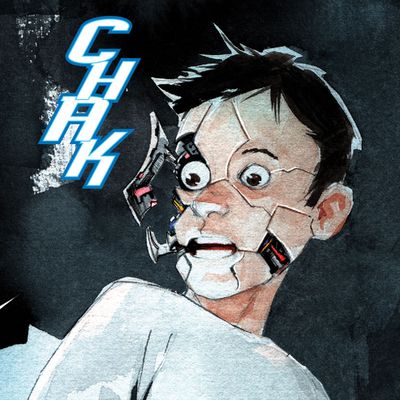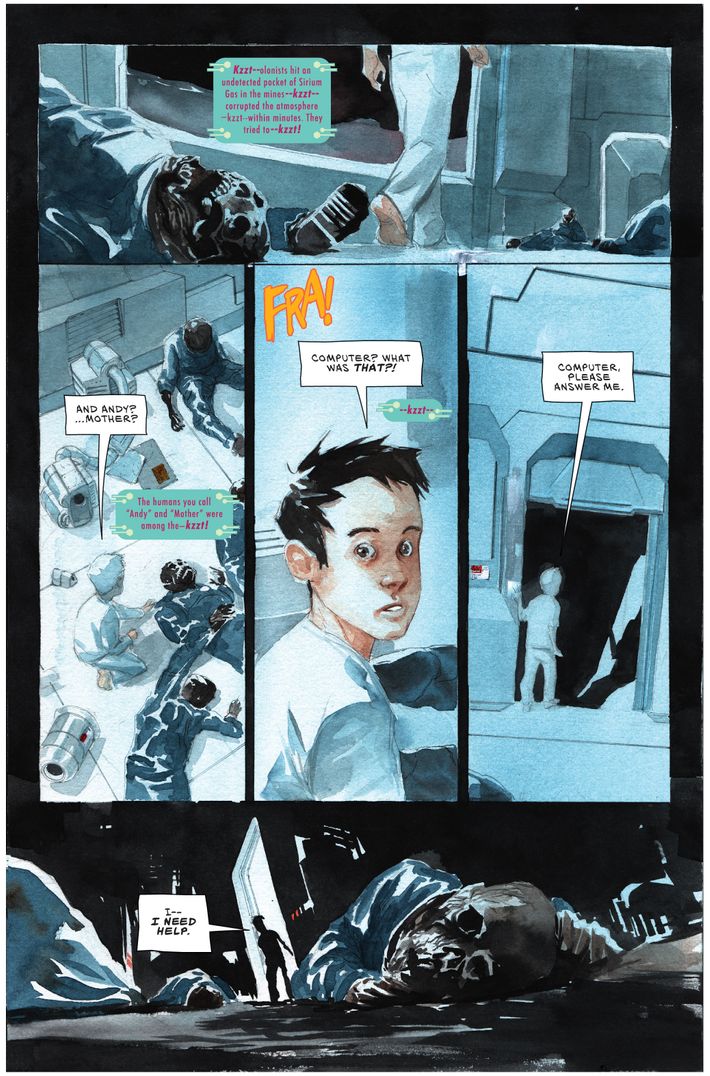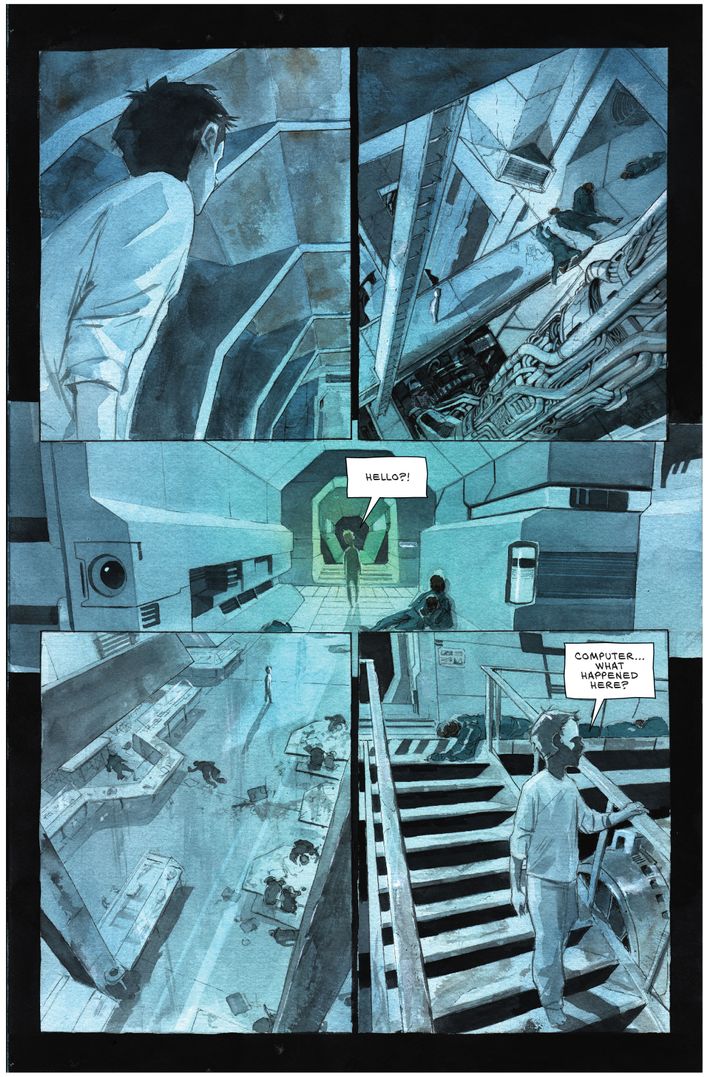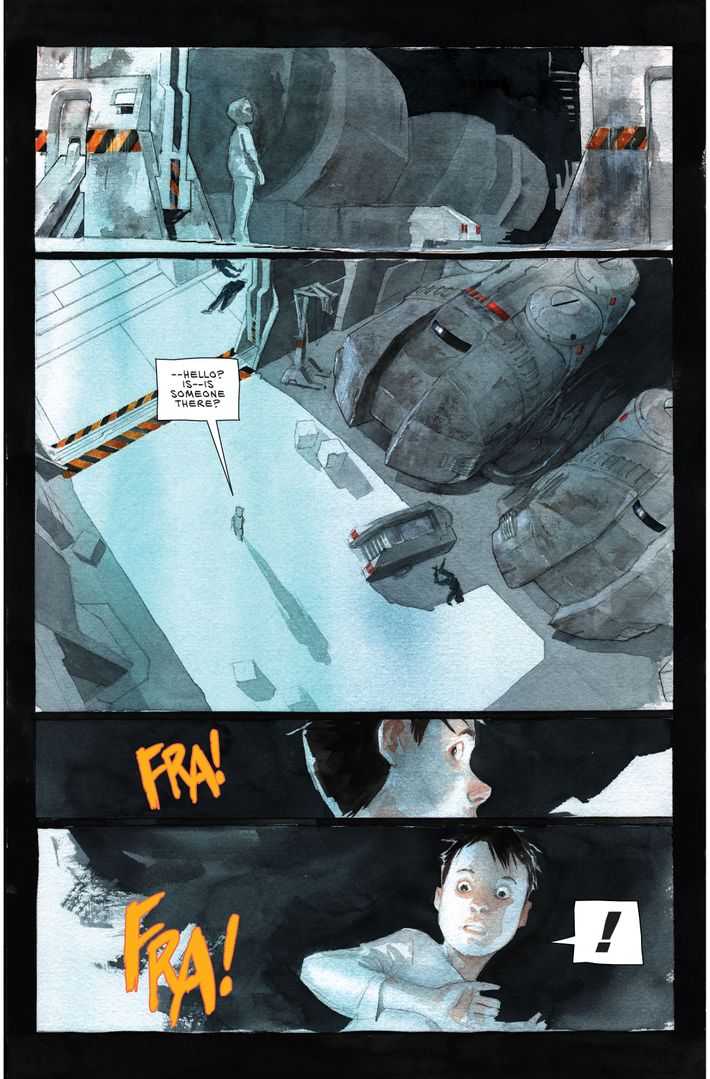
Its a well-known fact that robots and space travel are two great tastes that taste great together. 2001: A Space Odyssey, WALL-E, Spaceballs  all these narratives would be made much poorer if you had a machine-free cosmos or automatons who merely wandered around Earth. This week, a gorgeous new story enters the canon of galactic tales featuring androids: Image Comics Descender.
The monthly series will follow the exploits of TIM-21, a robot built in the image of a young boy, as he tries to escape bounty hunters and other dangers. ItÔÇÖs penned by superstar writer Jeff Lemire (Sweet Tooth, Animal Man, Trillium) and drawn in fantastic watercolor by Dustin Nguyen (LiÔÇÖl Gotham, Justice League Beyond). ItÔÇÖs a big week in general for Lemire, because weÔÇÖll also see the debut of his run on MarvelÔÇÖs high-profile series All-New Hawkeye. We caught up with Lemire and Nguyen to talk about gadgets, great anime, and gas-based life forms.
Jeff, what do you think makes robots an interesting storytelling element right now as opposed to 10, 15, or 40 years ago?
Jeff Lemire: For me, all I can answer is why I was attracted to the story and why I came up with it. It was really just a story of this little boy whoÔÇÖs hunted and aided in a chase across the universe, feared by the very people he was programmed to serve. That was an interesting emotional hook for me: These robots who were designed by us and designed to serve us and help us, and then, once we turn on them, what could they do? Emotionally, that was very fascinating to me. Dustin has more of a love of the aesthetics of building the robot and stuff like that.
What was your initial elevator pitch for the series? How did you sell it to Image?
Lemire: The basic one- or two-item thing, was ÔÇ£a young robot on the run across the universe with a ragtag group of bounty hunters chasing him.ÔÇØ A very simple B-movie plot. I like taking those very simple ideas and approaching them from very intimate, character-driven places. So, even knowing how big the universe is and how starry and how broad, youÔÇÖre still experiencing it from a very intimate point of view: this little boy whoÔÇÖs not even really human, but is probably the most human character in the book. ThereÔÇÖs something heartbreaking about that that I like.
Dustin Nguyen: Hey, Jeff, wasnÔÇÖt our pitch to Image the easiest pitch ever? When you walked in, you came right out and you were like, ÔÇ£Hey, can I do a book?ÔÇØ [Laughs.]
Dustin, whatÔÇÖs different about drawing a robot versus drawing a human? Or a superhero who has lots of gadgets?
Nguyen: Robots are a little more interesting because youÔÇÖre trying to give emotional life. ItÔÇÖs easy with humans because less is more; you take the animation approach where you do a few expressions and it works. With robots, itÔÇÖs a little more complicated, but at the same time itÔÇÖs just fun.
Lemire: The way weÔÇÖre approaching it is thereÔÇÖs hundreds of thousands of different kinds of robots in this world, and theyÔÇÖre all different from one another in their shape and function. TIM, the main character, is very human and on the surface looks like a normal human boy. ThereÔÇÖs the big mining robot, whoÔÇÖs very bulky and huge and robotic-looking. And then thereÔÇÖs the small pet-bot. All three of them, and all the rest of the robots, are so different on the surface but theyÔÇÖre all connected underneath. These machines are the same thing. ThereÔÇÖs something I like about that.
How much time was spent on mapping out non-narrative stuff, like the way robots work or the structure of the universe?
Lemire: ItÔÇÖs ongoing, but I spent a lot of time world-building before stuff was ever said to Dustin.
Nguyen: Yeah, Jeff sent me an entire [series] bible. It was a sweet bible! We talk a lot about the robots, but thereÔÇÖs this one planet where ÔÇö and I donÔÇÖt know if you want to reveal it ÔÇö where everything is just made out of gas. I was just like, Shit, thatÔÇÖs crazy, dude!
Lemire: ItÔÇÖs this whole planet where the characters think itÔÇÖs a haunted planet full of ghosts, but really itÔÇÖs just gas-based life forms.
Jeff, was there any moment you had written down something in this bible and Dustin gave you a sketch that wasnÔÇÖt what you had envisioned, but was something better?
Lemire: Yeah, everything [laughs]. It was better. IÔÇÖm used to drawing stuff myself. But if weÔÇÖre gonna point to one thing, there are these giant destroying robots from the first issue that appear and I was really inspired by Jack KirbyÔÇÖs [comics characters the] Eternals and Celestials, so I sent that to Dustin as reference. And he came back saying, ÔÇ£I donÔÇÖt want to just paint the Eternals. I want to design them myself.ÔÇØ He did something thatÔÇÖs so much more individual and unique to our book! It still has that big, huge feel, but itÔÇÖs still our own.
How much were you guys influenced by manga and anime? Looking at the artwork, I kept thinking of the superpowered children in Katsuhiro OtomoÔÇÖs Akira.
Lemire: I donÔÇÖt know if we ever discussed Akira, but I had just read Akira last year for the first time. I donÔÇÖt know how I hadnÔÇÖt read it before, but it had a pretty profound influence on me just in terms of world-building. The other manga I read was [Naoki UrasawaÔÇÖs] Pluto. That was a bigger influence on this book than anything. And [Osamu TezukaÔÇÖs] Astro Boy, thatÔÇÖs definitely a huge influence, that and Kubrick.
Dustin, are you an Akira fan?
Nguyen: With Akira, I just like the mechanics of it. It was made back in the ÔÇÿ80s and ÔÇÿ90s, when everything was bulky. When you drew a machine, it had to look like a machine.
Jeff, youÔÇÖre taking over Hawkeye, a Marvel series about two superhero archers who both go by the name ÔÇ£HawkeyeÔÇØ: Clint Barton and Kate Bishop. Writer Matt Fraction and artist David Aja just finished an acclaimed run on the series. How is your approach going to differ from theirs?
Lemire: When I was offered Hawkeye, it was very intimidating at first, because that book is so loved and so successful, commercially and critically. The worst thing you could do is try to imitate what they did, because in the end youÔÇÖre just going to get a watered-down version of what they did. For David and Matt, that was a very personal and specific project that I think is the perfect synthesis of both of their aesthetics. For me to try to copy that, it would not be successful. And to be honest, Ram├│n P├®rez, the artist IÔÇÖm working with, and myself, are both quite accomplished already as well. We had to make the book as personal and individual to us and our style as they did to them.
ItÔÇÖs different from what they did for sure. ItÔÇÖs much more like my independent work on Essex County or the kind of stuff Ram├│n did on Tale of Sand. ItÔÇÖs very specific to our aesthetic and our storytelling style. We used that to explore different aspects of what it means to be Hawkeye ÔÇö both for Clint Barton and Kate Bishop. ItÔÇÖll feel like the same characters in the same world, but from a different perspective.




